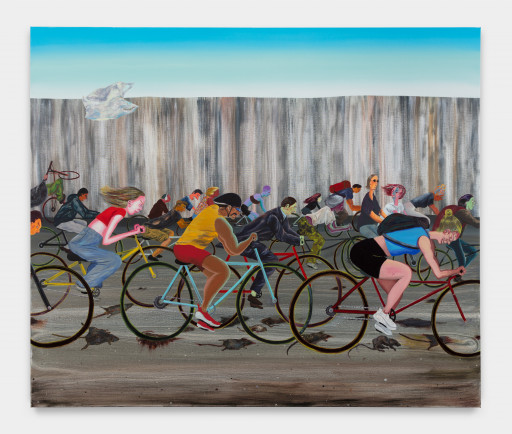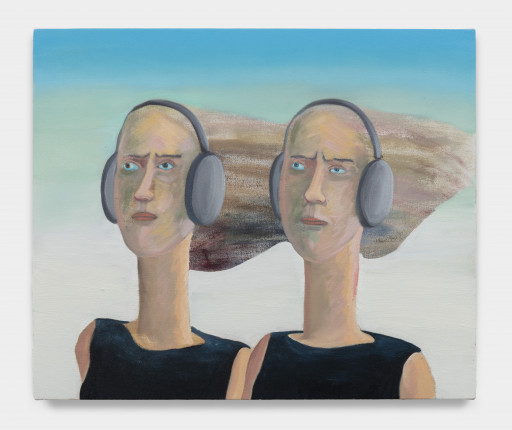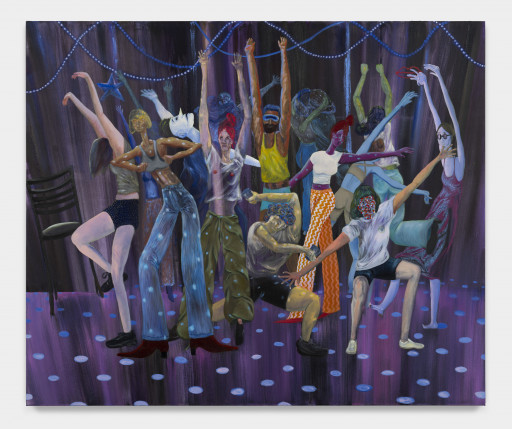Friends Indeed is pleased to present High Speed, a solo exhibition of new paintings by New York–based artist Maggie Ellis.
Working in the tradition of elaborate figurative scenes dating back to the Renaissance, Ellis reconceives compositions drawn from Botticelli and Pieter Brueghel the Elder. Steeped in references to contemporary anxieties surrounding climate change and the attention economy, Ellis’s canvases create a throughline between the past and present.
Ellis works from memory, sketching strangers she observes in the day-to-day of her life in New York. She realizes the figures as they exist in her head—misremembered and partly formed, ripe for reinvention. Then, she compiles her drawings such that the figures, seen at different times and in different parts of the city, exist on the same plane, confronting or engaging each other. Beginning each painting without a predetermined sense of place, Ellis instead intuits an environment with abstract gestures, which she then develops into a tangible location peopled with her characters.
The painting Flat Rat (all works 2022) pictures a crowd of cyclists racing at top speed with grimacing expressions, each trying to get ahead. The bikers are oblivious to the ground beneath them, where dead or dying rats are squashed, flat, and bloody. It’s easy to identify with the rats, trampled under so much competition—the organic detritus of the capitalist machine. The painting is comical in its sense of urgency and trippy in its coloration. Ellis’s range of approaches to mark-making and acidic hues lend a sense of individuality and uniqueness to each figure. Like James Ensor’s subjects, each is suffering from their own desires or crises. Ellis’s references are far flung: the chaotic street recalls Jean Dubuffet’s cityscapes, a floating plastic bag recalls the film American Beauty, while the background wall might be a freeway sound barrier or evidence of a divided state.
Pizza Party depicts an orgiastic bacchanal, featuring characters Ellis glimpsed on the subway. The painting situates humans and animals together in a park, rejoicing and gorging themselves side by side in a twisted pastoral scene. It’s a Peaceable Kingdom for the age of Pizza Rat. The revelers search for transcendence in the confusion of a crowd, animated by an ecstasy found not from religion (à la El Greco’s swirling figures) but from chemicals. Their outstretched arms grasp for something unknown. It’s as if, a century after George Grosz envisioned Metropolis, the painting’s battlefield arrived in contemporary Central Park; or if the soldiers of Piero della Francesca’s Arezzo cycle were recast as ravers. Ellis’s figures want to disappear in the crowd; they sway madly under a rotting sun.
The paintings in High Speed are connected by their elliptical groupings of figures. In each, a ritual or a rite takes place. In the fever dream of Those Who Run Seem to Have All the Fun, nature and culture collide. Walls give way to trees, and stars are replaced by a disco ball. Dancers contort, in pleasure or pain, while elongated figures make out in the background, denying what lurks in the shadows. Like all of Ellis’s canvases, the painting conveys a portentous clash of fantasy and reality. With an economic and sometimes scatological touch, Ellis distorts bodies to reflect the particular grotesque and sublime of our contemporary moment.
— Maria Calandra



